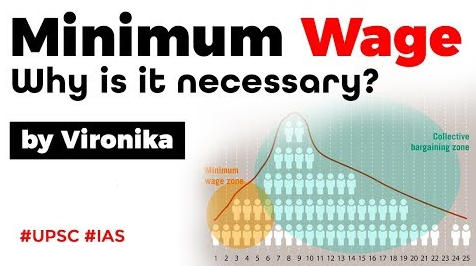Table of Contents
Context
- The Ministry of Labour and Employment on November 1 published the draft rules for implementing the provisions and sought comments from stakeholders until Dec 1.
- The code seeks to regulate wages and bonuses for all workers employed by any industry, trade, business or manufacturer.
- The Code replaces four laws — the Payment of Wages Act, 1936; the Minimum Wages Act, 1948; the Payment of Bonus Act, 1965; and the Equal Remuneration Act, 1976.
Need
- Minimum wages are accepted globally to be a vital means to both combating poverty and, equally crucially, ensuring the vibrancy of any economy.
- In the aftermath of the 2008 global financial crisis, the purchasing power worldwide got eroded.
Significance of the code
- The Code acknowledges that the aim in setting the floor wage is to ensure “minimum living standards” for workers and the draft rules incorporate criteria declared in a landmark judgment of the Supreme Court in 1992.
Impact
- A lot will depend on the final floor wage or wages (there could be different floor wages for different geographical areas) that the Centre will choose.
- The Labour Ministry had in February this year recommended that a “need based national minimum wage for India” ought to be fixed at ₹375 per day (₹9,750 per month).
Way forward
- Trade unions have voiced their reservations with multiple aspects of the Code and plan to submit detailed feedback.
- The points of contention include the nine-hour working day definition, a lack of clarity in the rules on scope for upgradation of workers’ skill category and the lack of representation for trade unions in the wage fixation committee.
Will it make difference?
- The Parliament passed the Code on Wages Bill, 2019 mandating a universal minimum payment of ₹178 a day.
- This wage prescribed is less than what was recommended by a high-powered labour ministry panel in 2019 (₹375 a day).
- It is also way lesser than the ₹700 fair wage that the 7th Central Pay Commission suggested.
Criticisms
- The Code lacked consistency in its use of both ‘worker’ and ‘employee’ terms and underlined that since minimum wage is a matter of right for every working person, a common definition of the employee/worker needs to be given in the Code. However, in the Bill retained the definition as it is.
- The definition of ‘wage’ is confusing, too long and too difficultto determine what wage is as per this definition.
- Provisions for different floor rates for different geographical areas will make the concept of a national rate a deceptive ploy to mislead people.
Challenges
- Potential threat from labour officials
- Less coverage of Code
- Counterproductive for bringing transparency
- Concentrating on more than one goal
- One of the labour ministry panel suggested a ₹1,430 housing allowance for city-based workers. This would allow for labour mobility and address the housing concern.
- As per Article 43, the state shall provide a decent standard of life and full enjoyment of leisure and social and cultural opportunities in particular to ensure a fair deal to the labour class. Article 39 reinforces the same. These goals have not been reached and the new code seeks to do so.






















 WhatsApp
WhatsApp